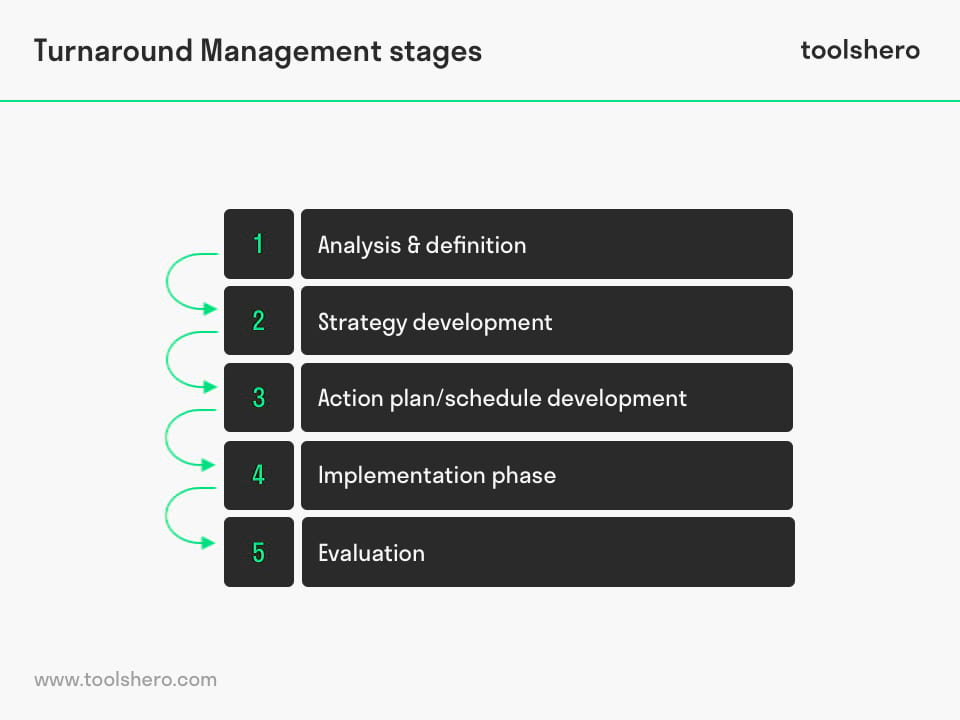Turnaround Management explained

Turnaround Management: this article provides a practical explanation of turnaround management. In addition to the basics of this concept, this article explains the context, the signals for the use and the stages. After reading you will understand the basics of this management tool approach. Enjoy reading!
What is Turnaround Management?
Definition
Turnaround Management is about the restructuring and renewal of a company in order to revive it. Such a management strategy is used when the company is under financial pressure, or when it’s struggling to keep up with the competition.
It’s crucial not to wait too long before intervening. The turnaround management process has to begin before it’s too late.
In some cases, an external expert is engaged to offer support. In that scenario, this management strategy is quite similar to interim management or management coaching.
The most important elements in turnaround management include analysing, planning and implementing a strategic plan to free the company of issues and obstacles.
It uses analyses and planning to return the business that is in trouble back to solvency. It identifies the reason for the lack in performance in its market and corrects it. After approval of the plan, a management expert executes the plan.
In practice, this management strategy is often experienced as slow and complex. That’s because the process goes against the natural way the business is run, which takes time.
Turnaround Management context
Turnaround managers are also called turnaround practitioners and work for the organisation in question for as long as it’s in the turnaround phase. Depending on complexity, these assignments can last anywhere from three months to two years.
Turnaround management is not just applicable to businesses in financial trouble; it can also be used to cover a gap in management or skills. It is also useful in situations in which the course or strategy of the organisation changes and needs to be implemented.
That means this management strategy is closely related to change management. Organisations that are dealing with extreme growth are another target for turnaround managers.
Most turnaround managers are self-employed, like interim managers, and use day rates. Other managers work for large turnaround management organisations.
Signs for When to Use Turnaround Management
Managing a business is a comprehensive process, and its success in part depends on proper leadership and accurate market and reporting data. There are many reasons for organisations to feel the use of turnaround management to be necessary.
Market signs
Businesses are constantly dealing with market fluctuations. The dynamic nature of the industry can weaken a business if it doesn’t react in time. As a result, organisations can lose market share to their competitors, requiring a turnaround.
The causes of market challenges can be diverse. Sometimes, these are caused by technological developments, or rather technological obsolescence. Other times it’s the marketing strategy.
On the other hand, it is also possible that a company is going through a growth spurt, whether intended or not. Extreme growth often leads to issues, and means that management has to work with small or no margins at all.
Internal signs
Information that’s reported within the organisation serves as the foundation for management decision-making processes. When the internal reporting mechanisms don’t work well, this can lead to problems with the choices that are being made.
This can pull the organisation into a downward spiral of bad decisions, based on a single prior bad decision. It can also lead to management becoming stuck in a strategy that worked in the past, but is now no longer valid. Redesigning the organisational structure, through turnaround management, and operations can then be a way to turn things around.
Internal crises can also be a reason to use turnaround management. Examples would be losing an important leader or conflicts within the organisation.
Turnaround Management stages
The process of each case is different, but there are a number of stages that are typical for turnaround management. These are explained below.

Figure 1 – the stages of turnaround management
Phase 1: Analysis & definition
During the first phase of turnaround management, the performance issues of a company are clearly defined. Any critical financial indicators are analysed thoroughly to halt any further decline.
The first phase usually lasts no more than two weeks. Information is collected about the following aspects:
- Historical financial data
- Stakeholders
- Cause of the problematic situation
- Potential solutions
- Risk analysis
Phase 2: Strategy development
After the problems have been identified, it’s time to start a strategic planning process. This phase is also called the stabilisation phase.
An important part of this is identifying strengths and weaknesses, as well as threats and opportunities (SWOT analysis).
The strengths and weaknesses become clear after an internal analysis, and the information about the company’s threats and opportunities comes from an external analysis.
Based on the information gathered from this, a long-term vision is created, and a mission and objectives are established. Some characteristics of the stabilisation phase are:
- Retake control
- Changes in leadership
- Emphasis on stakeholders
- Strategic focus
- Process optimisation (BPR)
- Restructuring (financial, business organisation)
Phase 3: Action Plan/Schedule development
An action plan is developed based on the new strategy. The action plan contains activities that have to be conducted to make the new strategy work as intended.
An organisation is based on strategy, so it can take some time for all processes to be turned around. Activities are subdivided into short, mid-term and long-term. Each activity contributes to the business’s turnaround and to the overall mission.
Phase 4: Implementation phase
The next step of turnaround management is utilising the action plan from the previous phase.
This stage can take several months up to a year. The implementation phase is not just about implementing the new strategy, but also about guiding, supporting, and coaching the employees involved. It’s crucial that every job is based on the general vision and mission of the organisation.
To support this, the company can:
- Create a communication plan
- Hold meetings
- Provide regular coaching
- Create points of contact for questions / feedback
Phase 5: Evaluation
During the last phase of turnaround management, evaluation starts even if implementation hasn’t been completed 100%. Regular evaluations are conducted to monitor critical issues and, if necessary, correct the strategy to achieve higher efficiency.
Turnaround Management summary
Turnaround management is about giving new life to an organisation by implementing far-reaching restructuring and changes. The basics of turnaround management are similar to interim management. The most important part of turnaround management is strategic planning.
An organisational turnaround might be required because of weak prior policies, or because of market developments. Internal processes are often at the heart of troublesome situations that require turnaround management to offer a solution. The turnaround of a business can be divided into several stages.
The first stage is identifying critical issues or problems. The second stage is about starting to stabilise the business. The other steps can be compared to the steps in the process of strategic planning.
Now It’s Your Turn
What do you think? Do you recognise the explanation of turnaround management? Can you name an example of an organisation that’s going through this process? What do you feel is important when changing an organisation’s course? Do you have any tips or additional comments?
Share your experience and knowledge in the comments box below.
More information
- Di Primio, A. (1988). When turnaround management works. The Journal of business strategy, 9(1), 61.
- Hofer, C. W. (1980). Turnaround strategies. Journal of business strategy, 1(1), 19-31.
- Khandwalla, P. N. (1983). Turnaround management of mismanaged complex organizations. International Studies of Management & Organization, 13(4), 5-41.
- Lenahan, T. (1999). Turnaround management. Elsevier.
How to cite this article:
Janse, B. (2019). Turnaround Management. Retrieved [insert date] from Toolshero: https://www.toolshero.com/management/turnaround-management/
Published on: 12/23/2019 | Last update: 04/05/2023
Add a link to this page on your website:
<a href=”https://www.toolshero.com/management/turnaround-management/”>Toolshero: Turnaround Management</a>












